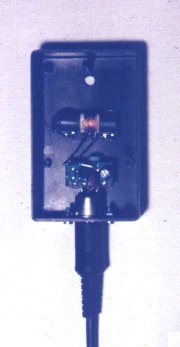


If you can't find the specified DCF77 receiver (Conrad 19 06 91)
you can try with a commercial DCF clock or alarm clock. Inside you should
find two IC (a receiver and a clock chip): between these two ICs there
should be a connection where the DCF signal is transferred (100
and 200ms pulses). Some simple measures with an oscilloscope will quick
allow you to find the right connection.
So connect this wire to pin number 2 (of the DIN3 connector)
of the interface, remove the 100kOhm resistance and the
100nF capacitor connected to it and connect pin number 1 to
the receiver ground.
On pin number 3 a stabilized voltage of 1.8V is available,
and can be use to power the receiver and its attached clock.
If the DCF signal is inverted on your receiver (LED stays
always on and blanks off each second except the 59th) swap pins 2 and
3 of the TL.081.
The above photograph shows the Conrad receiver mounted in a plastic box with the ferrite antenna (the two capacitors are not visible since they are situated under the PCB).

A second possible solution, is to build a new receiver: I propose a simple circuit with the famous U.4224 manufactured by Temic. You will also need a DCF77 antenna (it's a small ferrite antenna with an inductance and a capacitor; already tuned on 77.5kHz) and two 77.5kHz crystals (the crystal connected between pins 5 and 6 can be substituted with a 10pF capacitor).
The connector can be directly plugged into the interface; anyway pin 1 of the DIN3 connector is the ground, pin 2 is the open collector output and pin 3 is for supply (from 1.2V to 5.25V at about 25uA).
Remark: I didn't test this circuit.


| Back to DCF77. | 
| Back to the home page. |

| Previous page. | 
| Next page. |


| Questa pagina è disponibile anche in italiano. |
